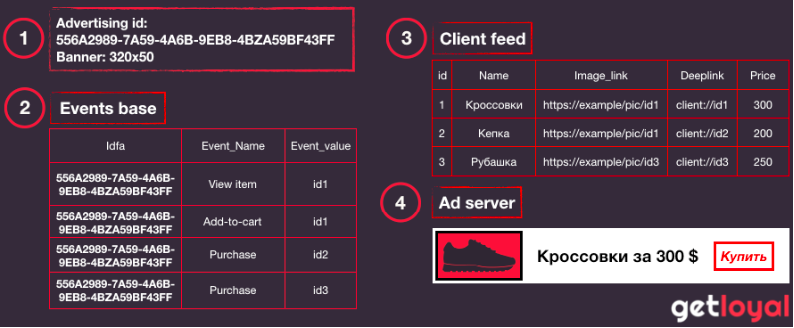How to run dynamic retargeting effectively in a mobile application
Dynamic retargeting is one of the most effective ways of retargeting, returning users to a mobile application. In the article from Getloyal, we will explain how it works and where they launch dynamic retargeting. We will also share the test results and recommendations that will increase the conversion to the purchase.

Dynamic retargeting allows you to create unique content for each user based on the events that he committed earlier in the application. In simple words, the user on the banner are shown only those products that he viewed. When you click on a banner, the user gets on the page with a specific product of interest on the site or in the application. A personalized approach multiplies the odds of a user making a purchase.
To successfully launch a dynamic retargeting campaign, three main factors are needed:
')
The process of creating a dynamic banner is shown schematically in the figure below:

After a request is received to place a banner on a device with a specific advertising identifier (1), the system searches the database for actions that were performed by the user in the application (2). Next, the system determines which goods are associated with these events (3). The type of event to be searched for is set when creating a campaign. By the item number (service) in the client tape, the system finds the necessary parameters. After that, text information, product image and deeplink are substituted into the banner template (4) created in advance. After that, the banner in the form of HTML5 / JavaScript tag goes to the advertising platform and is displayed on the user's screen.
Today, you can run dynamic ads on Facebook, as well as in applications via the Demand side Platform (DSP). In our opinion, many people underestimate this source of traffic. Conversion to re-attribution and purchase through DSP is higher than on other sources. In most advertising campaigns Getloyal - conversion to reattribution exceeds 85%.
The DSP, in turn, is connected to the Supply side platform (SSP), which sells displays. The largest SSPs are DoubleClick, Mopub, Mobfox, Inneractive, Smaato, Adcolony. Connecting an SSP can take a long time, so when choosing a DSP, it is always advisable to specify the list of SSPs with which they work.
1. Of particular interest is the situation when the user performed the target action with several products at once (put it in the basket, for example). The question arises, which product is better to show? There are several solutions:


2. Placing a CTA button on a dynamic banner is another great solution. Clicking on it, the user enters the basket, where he has goods. This allows you to speed up the path from the click on the banner to the purchase, and thus increase the conversion.
3. Banners with text and price more effectively attract the attention of the user than banners with graphic elements.
Getloyal automated retargeting system has its own advertising server that allows you to create animated dynamic banners. The team also has experience launching dynamic advertising campaigns in mobile applications using its own DSP, as well as Facebook.
The Getloyal team conducted a test - the same users were shown two types of banner ads: regular banners and banners with dynamic content. The test results showed that the CTR (ratio of clicks to impressions) for dynamic banners is on average 20% higher. Dynamic retargeting is a promising way to promote an application, and personalized content is the future of mobile advertising.
Article author: Vladimir Galitsky, analyst at Getloyal

Dynamic retargeting allows you to create unique content for each user based on the events that he committed earlier in the application. In simple words, the user on the banner are shown only those products that he viewed. When you click on a banner, the user gets on the page with a specific product of interest on the site or in the application. A personalized approach multiplies the odds of a user making a purchase.
Three whales of dynamic retargeting
To successfully launch a dynamic retargeting campaign, three main factors are needed:
')
- Event database with information about the product (product id);
- Product feed - information on product offerings, brands, prices, images and links to the product page;
- Advertising server, which pulls up dynamic content and generates HTML5 - banner code;
How does dynamic retargeting work?
The process of creating a dynamic banner is shown schematically in the figure below:

After a request is received to place a banner on a device with a specific advertising identifier (1), the system searches the database for actions that were performed by the user in the application (2). Next, the system determines which goods are associated with these events (3). The type of event to be searched for is set when creating a campaign. By the item number (service) in the client tape, the system finds the necessary parameters. After that, text information, product image and deeplink are substituted into the banner template (4) created in advance. After that, the banner in the form of HTML5 / JavaScript tag goes to the advertising platform and is displayed on the user's screen.
Where can I run dynamic retargeting?
Today, you can run dynamic ads on Facebook, as well as in applications via the Demand side Platform (DSP). In our opinion, many people underestimate this source of traffic. Conversion to re-attribution and purchase through DSP is higher than on other sources. In most advertising campaigns Getloyal - conversion to reattribution exceeds 85%.
The DSP, in turn, is connected to the Supply side platform (SSP), which sells displays. The largest SSPs are DoubleClick, Mopub, Mobfox, Inneractive, Smaato, Adcolony. Connecting an SSP can take a long time, so when choosing a DSP, it is always advisable to specify the list of SSPs with which they work.
Recommendations for dynamic advertising from Getloyal:
1. Of particular interest is the situation when the user performed the target action with several products at once (put it in the basket, for example). The question arises, which product is better to show? There are several solutions:
- You can use several placeholders (places for placing goods) at once when creating banners. The example below illustrates the placement of three products at once on a 320x50 banner.

- You can also use simple animation when the image and text change after a while, or complex when the position of the image and text changes.

2. Placing a CTA button on a dynamic banner is another great solution. Clicking on it, the user enters the basket, where he has goods. This allows you to speed up the path from the click on the banner to the purchase, and thus increase the conversion.
3. Banners with text and price more effectively attract the attention of the user than banners with graphic elements.
Getloyal dynamic retargeting test results
Getloyal automated retargeting system has its own advertising server that allows you to create animated dynamic banners. The team also has experience launching dynamic advertising campaigns in mobile applications using its own DSP, as well as Facebook.
The Getloyal team conducted a test - the same users were shown two types of banner ads: regular banners and banners with dynamic content. The test results showed that the CTR (ratio of clicks to impressions) for dynamic banners is on average 20% higher. Dynamic retargeting is a promising way to promote an application, and personalized content is the future of mobile advertising.
Article author: Vladimir Galitsky, analyst at Getloyal
Source: https://habr.com/ru/post/358702/
All Articles